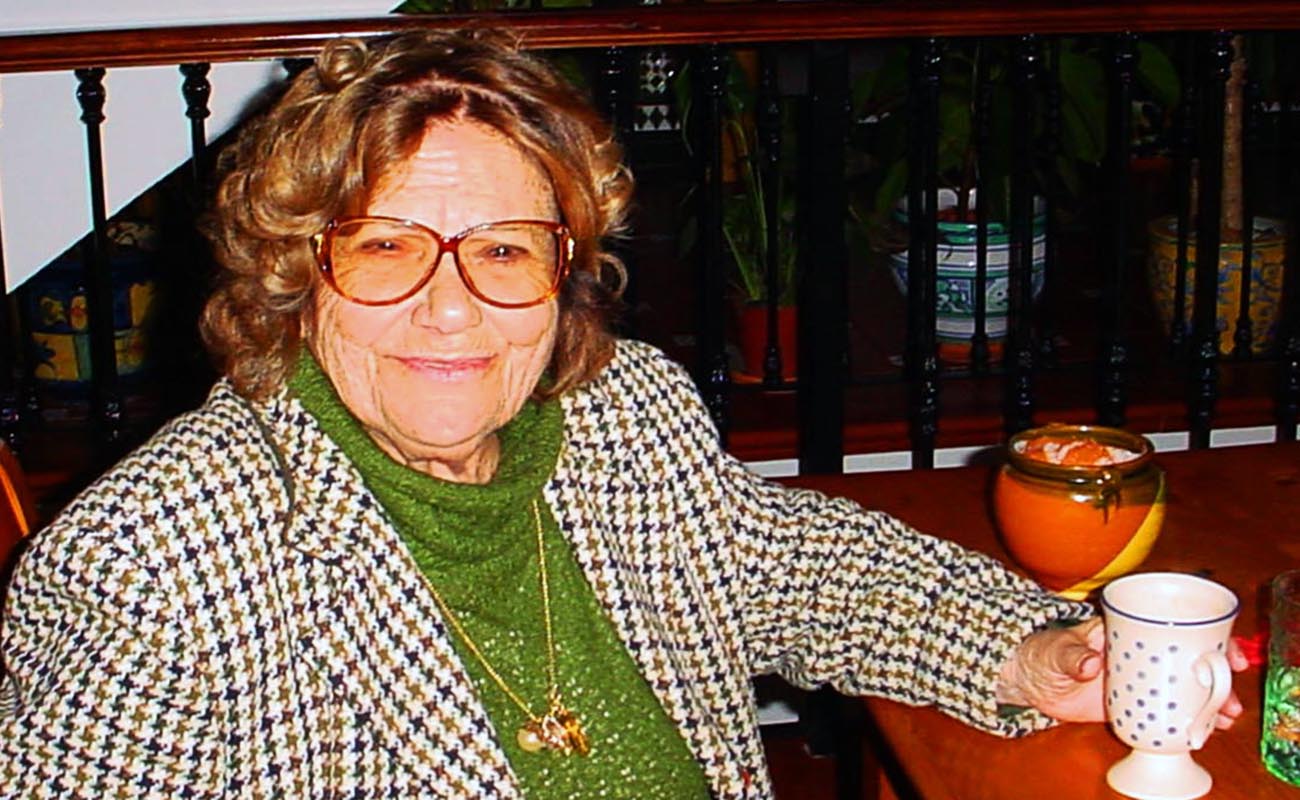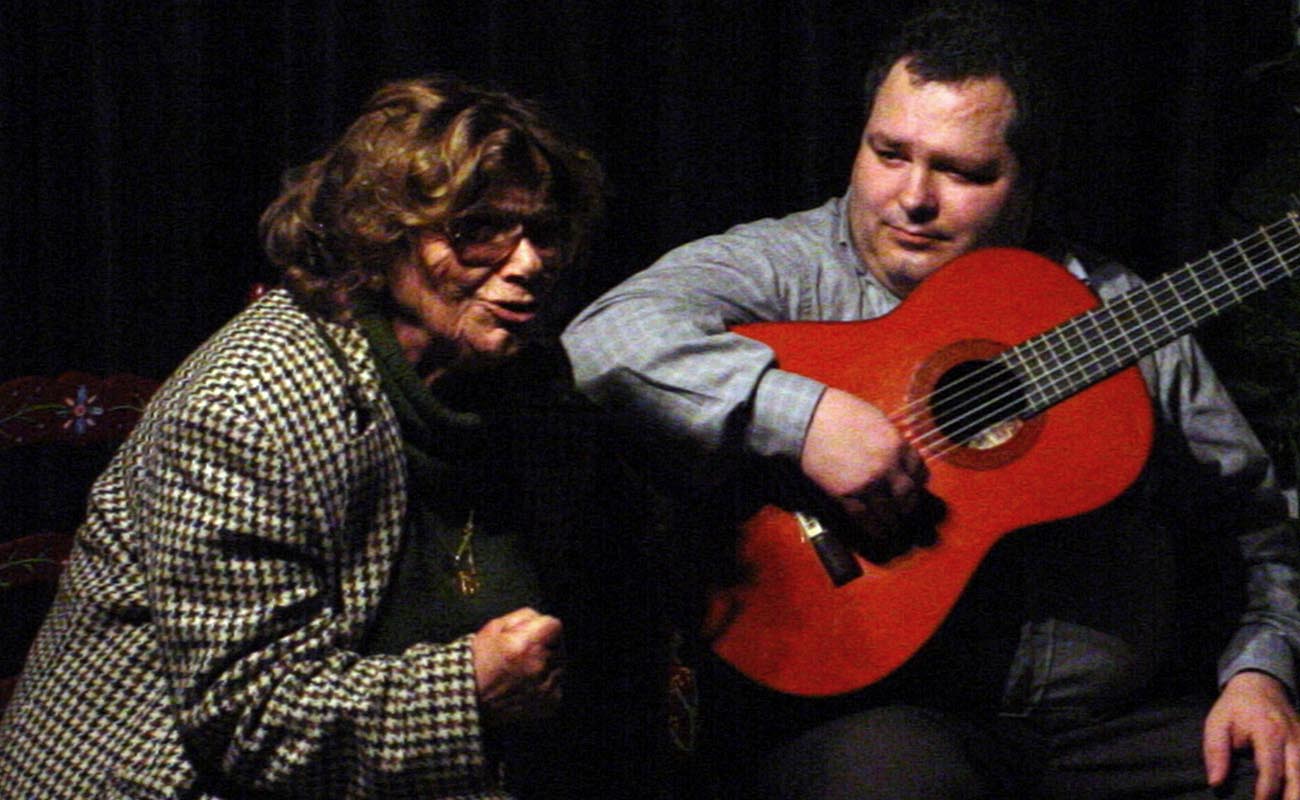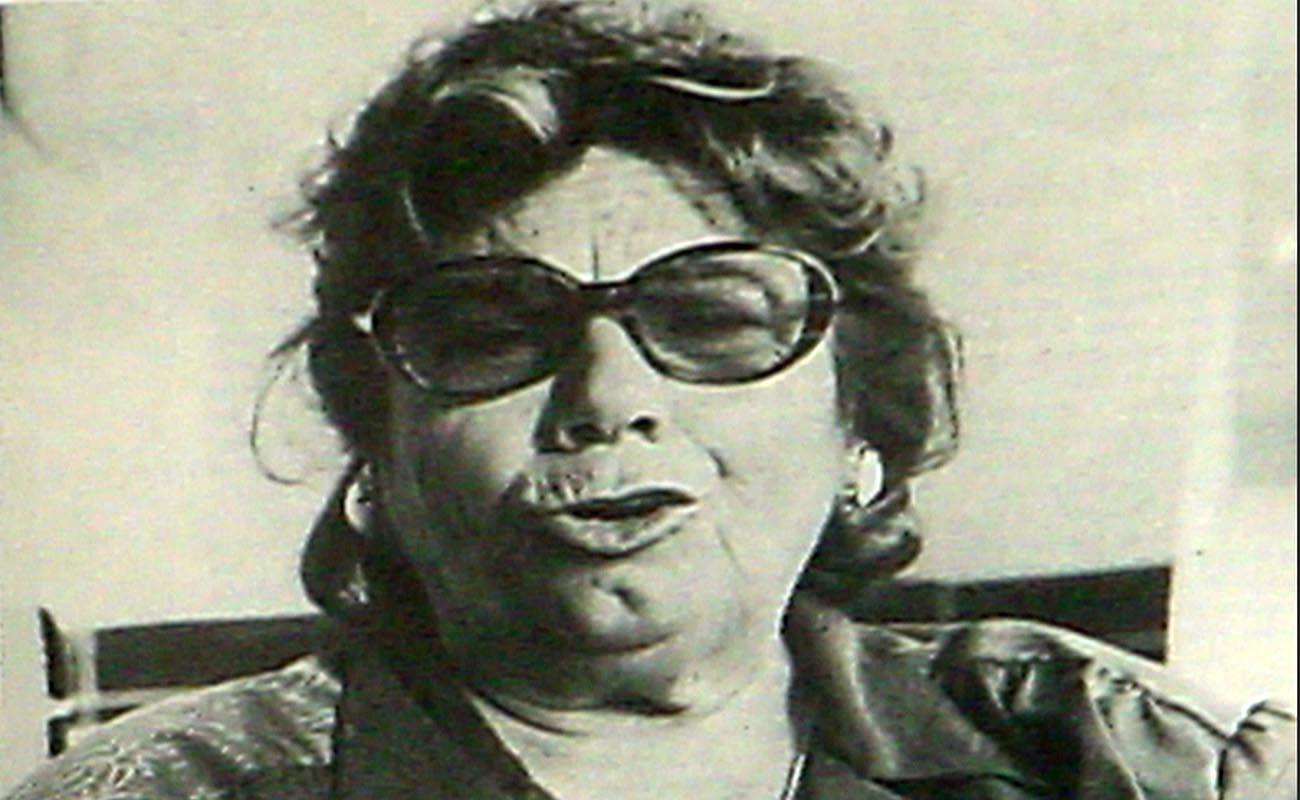Historic interview with Encarnación Marín, La Sallago
A woman born more than eight decades ago made the long trip from her hometown of Sanlúcar de Barrameda (Cádiz) to Almería to offer her timeless singing to a small group of flamenco followers.

Many were unaware La Sallago born in 1919 was still active, and it was an authentic luxury to meet this artist with a voice that brings back the simplicity of past times and the knowledge of an entire life in flamenco.
The encounter with Encarnación Marín wasn’t your typical interview with concise questions and answers. La Sallago wove in and out of anecdotes, songs, recipes, memories… At times, she appeared to be speaking in verse, with that rhythm and grace Andalusian people possess in such generous quantities. In the Cádiz tradition of Espeleta and Pericón, she related zany stories with enthusiasm, eyes atwinkling and hands gesticulating. Fernando Moreno, the guitarist who drove her from Sanlúcar to Almería, and who accompanied her recital, assured us with a big grin “she didn’t stop the whole time, we had a grand time with her!” She’s famous for her saetas, but in actual fact is a very complete singer with an unmistakable personal sound. She was quite a rebel in her youth at a time when young people didn’t rebel. In earlier interviews, she spoke of her difficult marriage, but seems now to have forgiven everything, wanting only to laugh and “sing a lot so people can hear how the Sallagos and people of Sanlúcar sing”. Two topics dominate this lady’s conversation, two faces of the same coin: childhood and old age. The childhood of the children she never had…and her own old age.
We’re in the home of Norberto Torres, writer, guitarist, founder and member number one of the flamenco peña El Ciego de la Playa in Huércal, Almería. The lady asks for a cup of coffee “burning hot, burning!”, and the first words she utters reveal what a sassy character is sitting in front of me: “My name is Encarnación Marín ‘Sallago’, and I’m 83 years and 50 days old”. She then leans over to me and whispers: “I’ve got this terrible cold, know what I mean?…ask for a bit of whiskey for me so I can get through this”.
Encarna, you were widowed in 1969, right?
And how’d you know that?
Because I’ve been studying up on internet.
And how does that go? I was singing in Puerto de Santa María when I lost my husband.
The reason I ask is because you made your first solo recording in 1972 at the age of 53. Did marriage limit you professionally?
It was extremely difficult to go out on your own. In Sanlúcar there’d always been women who sang, both young and old. You’d go out for a coffee and already you were being invited. And the paid fiestas of course, but my beginning was always amid friends. My husband never minded that, he knew my mother sang, my two elder brothers sang very well, both gone now, and the one who’s still alive also sings, but none of them became professional. I’m the only professional singer in the family. Why? Because I loved it, and I love Holy Week and the saetas (traditional Easter songs), which is how it all started.
I was always working, I was the eldest, and endured some really hard times. My brothers took to fishing, and I sold fish from a plate, I was just a little girl. It was Easter week when people came to know me singing saetas. There was the Virgin on Barrameda street. I was in the Bar del Rocío and when I saw the Esperanza, a cousin of mine pushed me up to the front: “Now is when you have to sing, not when you’re at home!” And I sang, and that’s how it all began. By the age of 14 I was supporting myself singing in Sanlúcar, but not because I was looking for that, but because people knew we were bad off, and the cupboard was bare. My mother didn’t know I was singing: “Matilde, your daughter’s singing in all the neighborhoods, what a scene!” And my mother said “that can’t be my daughter, she has no time for singing”. But everyone in the neighborhood would give me a coin or so, whether they could afford it or not.
Your grandmother was from Lebrija, wasn’t she?
I don’t understand how you know all these things, what’s that about “internet”?
Well, there’s a lot of information and it comes right through the telephone line.
Wow, that’s amazing! Yes, my grandmother was from Lebrija. She went to Sanlúcar de Barrameda to find work, and went to the port where she met and fell in love with my grandfather Sallago who came and went in the ships to the Americas. My other grandfather was from Galicia and everyone wants me to be gypsy, people say I must be from Lebrija or Utrera or Jerez. In Jerez is where I met the Domecq family. We used to go every day to sell whatever we could. We’d buy grain to grind in the mill, and when the Domecq people heard me sing, they took my baskets, and all the things I had to sell, and they said: “You’re not going to sell any more, you’re coming with us to Jerez”. From that point on, it was a steady stream of flamenco and fiestas, Jerez gave me everything, I swear to God. When I was still a child an image of me and my sister with long curls was painted on plates, like two sardines. So what else do you know about me girl? [laughter]
Did you know Manuel Torre?
Manuel Torre wasn’t Manuel Torre, he was “Niño de Jerez”. And my mother would always say “Encarna, if you could only hear how Niño de Jerez sings…” That Manuel Torre thing came later on, because he didn’t like being called Niño de Jerez, and because he was very very tall.
Did you have access to recordings to listen to flamenco singing?
There were recordings, but in my house we never had one of those record players. And now there are many recorded singers I don’t like. Anything in the world can be learned, but what comes out is all that counts. Look, I can’t read and write. What would be the purpose? God gave me this ability, I know the art and I know the interpreters, the gatherings…
Pepe Marchena was very important in your youth, what would you say about him?
Marchena was a singer with a lot of music that was different, and really beautiful…his singing was endless, and he was admired the world over. When he died, I dedicated a song to him, Se Murió Pepe Marchena.
What are your favorite song-forms?
I sing everything, I love all the forms. My mother sang a lot of the old cantinas, that was always in my family. I like soleá, tientos, fandangos, malagueña, taranto…
In your youth, did they sing much soleá and siguiriya?
Mostly flamenco versions of lyrical songs, a lot of things of Imperio Argentina. She was pure gold, and I’m clay because I’m flamenco. Serious cante was less common. My grandfather Sallago sang the old-style siguiriya, as did my mother. My father also sang very well, but I never met him. And they used to sing great bulerías in my town, very laid-back [she marks rhythm on the table and sings]: “Yo tendí mi camisón, ay con lunares coloraos…” [“My dress with red polkadots, I hung it out…”], when I was a young girl I loved polkadot dresses with ruffles, and I was very mischievous…”…lunares, lunares, lunares, mi batita de lunares, el domingo me la puse y salieron los novios a pares” [“my polkadot dress, I wore it on Sunday and had the boys flocking to me”]. Lots of people came from Lebrija to hear the Sallagos, but not in a theater, to my house. Because my brothers loved a little drink and their work, that’s all they needed to be happy, they sang very well but didn’t want to sing outside home. And we were always worried we couldn’t spruce up the house, because we received a lot of visitors. And when my widowed mother sold shrimp she used to sing: ‘Sacando yo el copo lloré, porque quería un camaroncito y el viento rompió la red’ [“I cried pulling in the catch, because I wanted a shrimp, but the wind tore the net”]. These are old verses of Sanlúcar.
Did you know La Periñaca?
What a great singer Periñaca! She would say she was four times twenty, and now I have to say “four times twenty plus three euros” [laughter]. And neither one of us gypsy. Lots of people think otherwise, but no. There was one guy who said he’d found gypsies in my background, imagine! But it was all fake. One day when I sang at the Circo Price, and you can check out that it’s true, there was an award like a sports trophy, and all the singers wanted to give it to Antonio Molina, know what I mean? But that night I’d made such a splash the audience shouted “no no, for the gypsy girl!” they thought I was gypsy! Antonio Molina was furious, he said the trophy was to be for him. So they had to give another one to him separately.
You toured with Pastora Pavón, La Niña de los Peines, didn’t you?
Yes indeed, with Pastora and her husband el Pinto. In addition to Pastora Imperio, Pericón de Cádiz, Manolo Vargas… When my husband was very ill, I was singing with all those great stars. And I used to dance a lot in those days, I was also a dancer, you know? The thing is, now with this face and this body…because I don’t have wrinkles, I have crevices! If I came out dancing, people would kill me. But there are people who love me, that one from Rota with all the gold teeth, what’s his name? Agujetas! He’s crazy about me, takes me to his house in Rota, and he says “you stay here with me”. Just like Terremoto, he was also crazy about me, and Porrinas who loved me to bits and pieces. And La Niña de los Peines…one day we were at her bar in la Campana, Seville, and I asked her, “Pastora, how can I get rid of these bags under my eyes?” And she says “Get a steam roller!” My God she was so sharp!
You also knew Caracol, didn’t you?
Absolutely! I was always with Caracol. In my opinion, he was the greatest of them all. Also Perrate, what a great singer. Mairena knew a lot about cante, Paquera drives me crazy, and that Perla! Each one in their own way, it’s so beautiful, don’t you think? Gypsy cante, Andalusian cante and those songs from Aragón, and the ones from Jalisco… But what I like most is gypsy-style, because it comes from the heart.
In an interview with Manuel Herrera in 1989 you said “flamenco singing is being lost and needs to go back to where it was”. Has it gone back?
Who said that, me? Good heavens, how sassy! Singing continues and some of it is really good, like that José Mercé and Camarón, that’s real honest-to-God flamenco singing. I’m not that good, but it’s real flamenco all the same. Now there are a lot of people who are pretty good, but flamenco flamenco it’s not. They sing these little songs, you know, with a flamenco kind of voice. Let me tell you girl, these young people don’t fill the fridge with siguiriya and soleá, nor could I in my day. I also did my share of popular music, like the groups of young people now. I sing sevillanas short and sweet, different from everyone else. And no one gives me the verses, I make them myself. Some of the young people are extremely good…and this guy who dances, what’s his name? Canales!…what an artist, I really like him a lot.
So is traditional singing being lost?
[There’s a long pause] I don’t think it gets lost, because there’s always a select audience, worthwhile things are never lost. Audiences can be more or less knowledgeable. Young people go for the fun, and these pretty young women, and the cute guys. If someone like me comes on singing, since they don’t understand it… A couple of years ago I sang in Rota, and it’s painful to remember but, well, when I came on-stage everyone gasped “oooh”, like they felt sorry for me, know what I mean? I’ve come to terms with reality in that sense. Girl, I’m not pretty to look at… [she knocks out rhythm on the table and sings]: “Qué feíta es la vejez, desaparece la ilusión, y ya no hay naíta que hacer”, [“how ugly is old-age, all your dreams dry up, and nothing you can do about it”].
That night at the flamenco club no one seemed to care about the singer’s lack of physical beauty. There were many young people in the audience, as well as older ones, gypsies and non-gypsies. And la Sallago easily won them all over with her richly worn voice, her still admirable faculties and her delightful personality. They all loved her and cheered her on at every moment. Encarna wove a tapestry of little songs and dances, and observations about the realities of life, and her words become music again. She’s clearly comfortable with Fernando Moreno who accompanies her lovingly…malagueña, tientos, soleá, tangos, bulerías siguiriyas, fandangos… She returns the admiration singing again and again, “¡Qué bien toca mi Fernando, con ese ritmo y ese compás!” [“How well my Fernando plays, with all that rhythm!”] When a small child runs across the stage, he’s scolded by the grown-ups, but the singer hushes the adults with a verse she makes up on the spot about the beautiful innocence of childhood, and the children “I never bore”.
Estela Zatania. Almería, February, 2002
Encarnación Marín “Sallago” passed away in 2015 at the age of 96.









